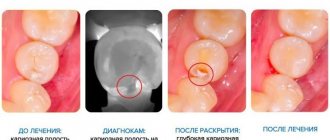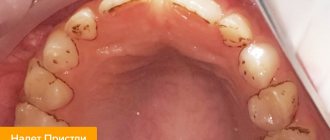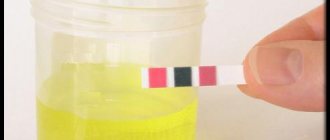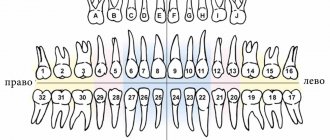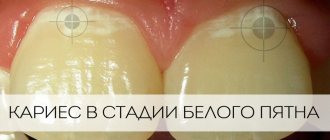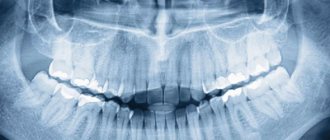Our food is a supplier of nutrients that are used for cell growth and development. If there is a lack of any vitamins and minerals, then the normal state of the body begins to suffer. Teeth are no exception. With an incorrect and unbalanced diet, they can begin to break down. On the one hand, this is due to the weakening of protective barriers, and on the other, to direct damage to the structure. How to eat right to maintain and increase the health of the dental system?
When the foundations of health are laid
The development of the baby's skeletal system begins at the end of the first month of pregnancy.
- From the 21st day the formation of the spine begins.
- At the 6th week, the rudiments of arms, hands and legs appear.
- At the 8th week, joints begin to develop, the fingers on the hands separate, and the process of ossification “starts”: cartilage tissue is replaced by bone.
- At the 14th week, intensive skeletal growth begins.
- By the end of the 16th week, the fetus is already fully formed: it has all organs and tissues, skeleton and joints without exception. But the process of ossification will continue for a long time and will end only with the completion of puberty.
Teeth also belong to the skeletal system. They begin to erupt on average at six months of age. This happens in two stages: first, milk teeth appear, then, after 6 years, they gradually change to permanent ones.
But the foundation for healthy teeth is laid much earlier than they begin to erupt. Like the skeletal system as a whole, tooth germs arise and begin to develop in utero. The most important factor that determines the future health of the baby’s bones and teeth is the nutritious nutrition of a pregnant woman. Therefore, the expectant mother should pay increased attention to a balanced diet with a full set of all necessary micro- and macroelements - vitamins and minerals.
Look at our infographic - the diet of a pregnant woman (briefly about the important things).
To ensure the health of the skeletal system, we first need elements such as calcium, magnesium, phosphorus, vitamins D and K. Let's talk about each of them.
When to start prevention
You should think about the condition of your child’s teeth from the first months of pregnancy. Women need to remember that the baby’s skeleton and dental system are formed in the early stages. Therefore, a pregnant woman is recommended to consume foods that are good for teeth and bones in accordance with increased standards.
Specialists at the Shifa clinic will provide patients with detailed information about which products are good for children’s teeth. Dentists conduct preventive examinations and dental treatment for pregnant women. At the same time, they place special emphasis on prevention and analyze the diet in detail to find out whether it contains healthy foods for teeth in sufficient quantities. This approach allows you to keep a pregnant woman’s teeth healthy, and also contributes to the formation of healthy teeth in children.
Regular dental check-ups will help avoid many dental problems.
Calcium and nutrition during pregnancy
Calcium is one of the most important macroelements in the human body. It is a building material for the skeletal system: 99% of calcium is concentrated in bones and teeth. In addition, it plays an important role in the proper functioning of the muscular, nervous, cardiac, circulatory and hormonal systems, as well as in the activation of enzymes that convert food into energy. Therefore, if low levels of calcium are detected in the blood, the body takes it from bone tissue to make up for the deficiency in these systems.
It is especially important for pregnant women and nursing mothers to get enough calcium. And vitamin K, in particular its variety, vitamin K2, which is found, for example, in Agusha curds, helps this element integrate into the bones.
Be sure to read our article about vitamin K2 and notes from the famous baby nutrition expert V.M. Kodentsova about the importance of vitamin K2 for the development of a child.
The need for calcium during pregnancy increases, since now this element is used not only for the needs of the woman’s body, but also for the construction of fetal bone tissue. To avoid calcium deficiency, you need to think through the diet in such a way as to prevent it from being washed out of the woman’s bones and teeth, and this is what happens when the fetus does not have enough calcium from the mother’s diet to build the skeleton. A sufficient amount of this macronutrient in a woman’s diet, including during pregnancy, is necessary to prevent the manifestations of osteoporosis.
- It is useful to include dairy products in the expectant mother's diet: cottage cheese, yogurt, milk, kefir, hard cheeses, as well as fatty fish. There is a lot of calcium in green leafy vegetables (for example, 100 g of spinach contains up to 106 mg), legumes: beans, soybeans, beans, parsley (another “champion” - up to 245 mg per 100 g of product).
- Celery, white cabbage, almonds, and greens also contain calcium.
Read more about nutrition during pregnancy in our special material “Eating Healthy During Pregnancy.”
Features of treatment of baby teeth
Carious lesions of primary (temporary) teeth are widespread. The progression of dental damage in childhood and preschool age is observed in all countries of the world. The difficulty in treating caries in primary teeth lies not only in the anatomical and physiological characteristics of the child’s primary teeth and oral cavity, but also in the difficulty in adopting the right strategies when working with a child patient. This often leads to the development of complications of caries and premature removal of baby teeth, which in turn negatively affects the rudiments of permanent teeth, general health and can lead to the development of odontogenic inflammatory processes in the maxillofacial area and anomalies. That is why the problem of treating caries in childhood is especially acute.
Getting children and parents overcoming their fear of dentists is also an important aspect. Since the sound of a working dental unit is a powerful factor in the development of dental phobia, special attention is paid to creating a noise-free, “friendly” way to treat caries, especially in childhood. However, many modern treatment techniques (ozone therapy, laser or ultrasound preparation) have proven to be of little effectiveness in young children. Some other methods also have their drawbacks and do not always lead to good results. And the silvering procedure, for example, stains the teeth black, so many parents refuse it. In addition, silvering also causes many complications in the future.
Atraumatic restorative treatment of childhood caries and chemical-mechanical preparation of carious cavities have become the most promising techniques in pediatric dentistry. There is insufficient information in the literature regarding the use of these techniques in pediatric practice, the types of preparation and their impact on the behavior of children, and the indications and contraindications of these techniques are not clearly clarified.
In cases of deep caries, it is recommended to use a protective calcium-containing lining or perform a thorough fluoride treatment of the roof of the pulp chamber. This technique is rarely used in primary dentition, as it is believed that primary teeth are not often affected by deep caries. But on the other hand, the hard tissues of primary teeth have specific anatomical and physiological characteristics that contribute to the rapid spread of infection and the development of complications from small carious cavities. Treatment of intermediate caries protects the pulp and accelerates the mineralization of damaged dentin. In such cases, the use of fluoride compounds is recommended, although their reliable effectiveness remains unknown. Glass ionomer cements are used to restore primary teeth. In recent years, the treatment of caries with light-curing materials in primary teeth has been carefully studied by researchers. Although the justification of aesthetic restorations in primary dentition remains unproven, some other techniques for treating secondary caries in childhood are also poorly understood.
Object of study
Rationale for exhaustive therapy in the course of treatment of secondary caries of primary teeth in children aged 1-5 years.
The following tasks were identified:
1. Assess the behavior of children aged 1-5 years during various cavity preparation techniques
2. Compare the quality of various preparation techniques in children aged 1-5 years.
3. To identify the positive effect of using fluoride to treat the roof of the pulp chamber in children
4. Assess the justification of aesthetic restoration in children aged 1-5 years and establish the effectiveness of the light-curing materials used.
5. Develop the most effective and comprehensive method of treating primary teeth and find out its effectiveness in the age group of 1-5 years.
Scientific novelty of the research
The behavior of children in terms of the technique chosen for tooth preparation is examined for the first time. It has been proven that the use of atraumatic methods and chemical-mechanical preparation of carious cavities has a beneficial effect on the behavior of children, while the use of a dental unit affects the development of a deliberately negative attitude of children towards dental procedures. A comparative study of various preparation techniques (standard, atraumatic, chemical-mechanical) using a caries detector in children aged 1-5 years has not been conducted before. The use of a caries detector is necessary to assess the complete removal of carious dentin when using any of the preparation techniques. The use of fluoride to treat the roof of the pulp chamber of temporary teeth has shown its high efficiency. The need for aesthetic restoration of primary teeth in childhood has been established. The clinical effectiveness of treating moderate caries using light-curing glass ionomer cements has been revealed. A comprehensive technique for the treatment of caries in primary teeth has been developed, tested and then evaluated. The effectiveness of this method was 94.8% compared to the conventional method, which showed 83.5%. The study was conducted with the participation of children aged 1-5 years.
Scientific and theoretical significance of the study
The theoretical significance of the study was to obtain new information on a comparative analysis of various methods of preparing primary teeth in children, the effect of preparation on the behavior of children during this procedure, the need for aesthetic restoration of these teeth, the importance of using fluoride to increase the effectiveness of therapy.
The practical significance of the study lies in the development of a comprehensive and effective method for the treatment of caries in childhood. The need to use a caries detector is determined by the assessment of adequate preparation.
Research abstract
1. The behavior of children during oral sanitation measures significantly improves when using atraumatic and chemical-mechanical preparation techniques. While the use of conventional dental units causes negative emotions in children.
2. The use of a caries detector was carried out to assess the completeness of removal of infected tissue and the quality of preparation in all applied methods
3. The use of fluoride to coat the roof of the pulp chamber increased the effectiveness of therapy for primary teeth in children.
4. The exhaustive technique increased the effectiveness of treatment of moderate caries in primary teeth of children aged 1-5 years compared to the traditional technique.
Approbation of research results. Implementation of discoveries. Publication of abstracts.
The research materials were presented and discussed at the conference of young scientists of Volgograd State Medical University (2004-2006), the XI regional conference of young scientists in the Volgograd region (Volgograd 2005), the VI international scientific conference “Health and education in the third millennium” (Volgograd 2005).
The study was also announced at a meeting of pediatric, therapeutic, surgical, and orthopedic dentists in Volgograd State Medical Academy (September, 2006).
According to the established goals and objectives, a multi-stage study was launched. 448 children aged 1-5 years took part in it. The children were formed into groups according to gender and age.
Research base
Municipal children's clinic No. 2 in Volgograd. Participation in the study was voluntary. Informed consent for children's participation was obtained from their parents. The study protocols were approved by the regional ethical community. At the first stage, the attitude of parents (192 families) to various methods of preparation of baby teeth, as well as the behavior of children in the process of sanitation, was determined. 47 children underwent standard preparation techniques for primary teeth, 48 underwent atraumatic preparation, and 97 underwent chemical-mechanical preparation. Standard technique was performed using a dental unit, high and low speed handpieces, diamond, carbide and steel burs. The atraumatic method of preparation was carried out using the ART technique (Pakhomov, Leontyev 2004). The chemical-mechanical method for preparing the carious cavity of temporary teeth was carried out using the preparations “Carisolv”, “Medteam”, Switzerland. Glass ionomer cement was used for filling. Children's behavior during sanitation was recorded during the first four visits.
Criteria for parental assessments regarding treatment of children
1. Satisfaction with the treatment experience, full agreement with the doctor on all issues.
2. Dissatisfaction with the treatment method chosen by the doctor for one reason or another. The need to change it.
Children's behavior was assessed according to the following criteria
1. Good: the child is sociable, trusts the doctor, sits well and opens his mouth calmly
2. Satisfactory: the child is difficult, restless and reluctant to open his mouth. For complete treatment, the help of parents and medical personnel is necessary.
The second stage consisted of a qualitative assessment of the process using a caries detector in 53 children. With the standard preparation technique, the detector was used in 30 cases, the atraumatic technique in 15, and the chemical-mechanical technique in 62. To determine necrotic dentin, the “Color-test” detector (VladMeVa) was used. Using this detector, adequate cavity preparation was assessed in different ways.
The third stage of the study consisted of fluoride treatment of the roof of the pulp chamber in 78 children, as part of the treatment of moderate caries in children (145 children). The standard technique was applied to 215 teeth. Deep fluoridation was carried out using a bonding agent (liquid sealant), “Humanchemie”, Germany. During the fourth stage, parents' opinions were obtained regarding the aesthetic component of treatment (according to a survey of 100 respondents), and the effectiveness of treatment of moderate caries of 56 temporary teeth in 23 children aged 3-5 years was assessed using various preparation methods and further restoration with light-curing materials Vitremer TM, 3M ESPE.
During the fifth stage, based on surveys, a comprehensive methodology was developed for the treatment of moderate caries in primary teeth of children aged 1-5 years. Treatment included: preparation of carious cavities (ART, CMP techniques), use of caries detectors to assess the quality of preparation, deep fluoridation of the pulp chamber after preparation, filling with glass ionomer cement. This algorithm was applied to 381 teeth in 142 children. The standard method of treating moderate caries (preparation using a dental unit, filling with GIC) was used in the same group of children on 315 teeth. The localization of carious lesions in different techniques was approximately the same. After 18 months, the effectiveness of the exhaustive technique compared with the standard technique was established. To evaluate the results of treatment of average caries of temporary teeth, the following parameters were taken into account: the presence or absence of complications after treatment (pulpitis or periodontitis), secondary lesions, quality of filling according to the anatomical shape, preservation of the tooth surface and gingival attachment.
After the examination, the quality of treatment was assessed:
1) positive result: the filling restores the anatomical shape of the tooth, preserving the gingival attachment or the presence of a small defect without involving dentin, there are no signs of secondary damage or complications.
2) negative result: extensive damage to the filling, violation of the gingival attachment, uneven surface, loss of integrity, loss or abrasion of the filling, recurrent caries and complications.
All statistical calculations were carried out using an IBM Pentium 4 computer using software (Microsoft excel 2000). Marginal category (%), mean error (m), significance (t) and deviation (p) were reported. The deviation was considered statistically significant at t>2 and p
Research results
The interview results showed that the majority of parents had a positive attitude towards the need to treat their children and were satisfied with the doctor’s work. Only 4.2% of parents were dissatisfied with the experience. Regarding the behavior of children, the majority of patients from the standard treatment group (74.4%) showed a negative attitude towards therapy at the first visit, their behavior was unsatisfactory. Over the course of treatment, the percentage of children with a negative attitude towards treatment rose to 78.6%. By the second visit, the number of children with bad behavior increased by 12.7%, by the third - by 6.3%. By the fourth visit, no child was showing good behavior. Satisfactory behavior during standard preparation was observed in 21.4% of children. The majority (72.9%) of children showed good behavior with the ART method. Gradually, the number of children with good behavior increased to 93.8% by the fourth visit. The number of children with satisfactory behavior, which was 16.6% at the first visit, decreased to 2.1% at the fourth visit.
Bad behavior was observed in 10.5% at the first visit, the reduction in negative attitudes decreased and by the fourth visit it was already 4.1%. In the group of children in which chemical-mechanical preparation was used, good behavior was observed in 47.7%, its proportion increased to 52.5%, 74.2%, 97.9%, respectively, at the second, third and fourth visit. The number of children with satisfactory behavior was 27.8 and gradually decreasing, reaching 1% at the fourth visit. Also, the number of children with bad behavior decreased from 27.8% to 1% by the fourth visit. A comparative analysis of the results showed that children treated with ART and CMP techniques tolerated the procedure much easier than patients who underwent standard preparation. With the ART and CMP techniques, almost all children showed good behavior and attitude towards treatment, while with the standard technique, the opposite results were observed: the number of children with good behavior came to zero by the end of the procedures. Bad behavior and negative attitudes among children remained at a high level: 74.4% - 76.8%.
Qualitative assessment of the performed preparation of primary teeth.
The use of a caries detector revealed remaining infected dentin in all preparation techniques used. Although preparation defects were found more often (p
No statistically significant deviation was found during preparation using ART and CMP methods (13.3%+-8.8% and 24.2+-5.4%, p
Pros and cons of various techniques.
The rapid removal of infected tissue may be considered an advantage of the standard dissection technique. At the same time, the use of a drill leads to the development of a negative attitude and increases the level of dental phobia among the population. The ART method has significant advantages due to quiet, gentle cleansing of the cavity, minimal risk of opening the pulp chamber and damage to surrounding tissues, reducing fear and anxiety in children and their parents. However, this technique is applicable only to “open” cavities; it cannot remove all altered dentin. In addition, careful excavation can lead to infection of the dentin near the pulp horn and the enamel-dentin junction. Also, this technique takes quite a long time.
Advantages of CMP: painless and quiet procedure, comfortable implementation for children and parents, safe for the oral mucosa, maximum preservation of healthy tooth tissue, easy removal of affected tissues after softening with gel, the ability to manually expand the enamel boundaries, allowing you to create a sufficient cavity. Disadvantages of the technique: it is not always possible to open the cavity with a hand instrument, the gel may not always be effective in softening dentin, manual removal of carious dentin from the medial wall of the cavity of primary molars is ineffective, some children note an unpleasant odor of the drug, the time of extraction of carious tissue increases. The use of fluoridation of the roof of the pulp chamber before filling showed good results (Figure 3). A positive result after the procedure was observed more often than in the conventional technique 94.5%+-1.9% and 82.8+-2.6%, respectively, p
The problem of aesthetic filling of temporary teeth.
According to the results of a survey of parents, the majority of respondents (about 73%) consider it necessary to carry out aesthetic treatment for their children. 17% reported that they considered aesthetic treatment an advantage and 10% were undecided. At the same time, 33% are ready to choose a treatment method on their own, 60% completely rely on the doctor, and 7% find it difficult to answer. A small number of families (21%) can also choose their own filling material. On the other hand, the choice of therapy technique is also limited by the family budget. Despite this, 80% are considered to be families with a good income, most of them prefer free medicine (17%) or cheap treatment for caries of primary teeth (49%). Only 34% of respondents decide on aesthetic treatment for their children.
The use of light-curing materials in pediatric practice is limited by certain difficulties: the need to work with 4 hands, more time is required for treatment, the child must be calm and follow the doctor’s instructions, good isolation of the area from oral fluid. According to this, filling is very difficult in children under 3 years of age, in children who are not sociable, in active and inquisitive children who cannot sit quietly with their mouths open for a long period of time. Repeated examination of children after 12 months revealed that satisfactory results of using Vitrmer after the CMP technique were observed in 87.8%, after ART - 84.6%, after CP - 80%, the number of negative results -12.2%, 15.3% , 20.0% respectively. However, the deviations were found to be statically unstable (p0.05). The limitation on the use of light-curing materials is, on the one hand, due to the low aesthetic requirements of parents and their economic resources, and on the other hand, the complexity of the work associated with the behavior of children.
Comprehensive treatment of moderate caries of primary teeth in children.
Exhaustive therapy according to the study results includes preparation with CMP and ART techniques, use of a caries detector to assess caries excision, application of sealants to the pulp roof, and GIC filling. After the described treatment, positive results were found 18 months later in 94.8% of cases, after the standard method - 83.5% (p0.05), class III - 1.9 times less (17.9+-6.1% and 34.0+-6.7%, p>0.05), class IV – 6.2 times less *2.6+-1.5% and 16.1+-4.7%, p
Thus, the method of exhaustive treatment is recognized as the most effective and desirable for implementation in clinical practice.
conclusions
1. The behavior of children during oral sanitation depends on the chosen preparation technique: the use of new techniques (ART and CMP) leads to the formation of a positive attitude towards the treatment process in 93.8% -97.9% of cases. When using standard dissection techniques, a negative attitude is observed in 78.6% of children.
2. It is recommended to determine the quality of preparation of the carious cavity of primary teeth using a caries detector: this is especially effective when using the ART and CMP techniques. Preparation defects using the standard method are determined 2.8 times less than with chemical-mechanical preparation and 5 times less with atraumatic preparation.
3. Deep fluoridation of the roof of the pulp chamber significantly increases the effectiveness of treatment of moderate caries of primary teeth. The number of unsatisfactory results during fluoridation is reduced by 4.2 times compared to the standard method: 5.5+-1.9% and 17.2+-2.6%, respectively, p
4. The need for aesthetic treatment of children aged 1-5 years is 34%. The effectiveness of Vitremer is 85.5%, negative experience is 14.3%, which approximately corresponds to the data on GIC fillings.
5. Exhaustive treatment of caries, including preparation using ART, CMP techniques, the use of a caries detector, deep fluoridation of the roof of the pulp chamber and GIC filling is recognized as preferable. The use of this technique in children 1-5 years old increases the effectiveness of treatment by 11.3% compared to standard treatment: 94.8% and 83.5%, respectively, p
Practical recommendations
1. In the process of rehabilitation of children aged 1-5 years, it is recommended to adhere to the following recommendations:
— ART technique is recommended for active and restless children under 3 years of age, preschool age, experiencing severe anxiety and fear, and also having good access to the carious cavity
-CMP technique is recommended for children under 3 years of age, children of any age to establish a trusting relationship with the doctor, patients with a fear of the sound of dental equipment and injections, with a burdened allergic history, emotional instability and mental disorders.
- standard preparation techniques can be used for emotionally stable children, school-age children who are calm about the dentist’s manipulations, including anesthesia. If there is no good access to the carious cavity, the described techniques should be combined.
2. At the final stage of preparation, regardless of the chosen technique, you should use a caries detector to determine the quality of excision of affected tissue. It is necessary to ensure the absence of intense staining.
3. Treatment of moderate caries of primary teeth in children aged 1-5 years is recommended to be carried out using fluoridation of the roof of the pulp chamber, this significantly increases the effectiveness of therapy.
4. For the greatest treatment effect in children 1-5 years old, it is necessary to resort to an exhaustive treatment method, including all the stages described above, including GIC filling.
Author:
Dr. Dina Jafar Mohammad
How does calcium deficiency manifest itself?
An irresistible urge to chew chalk is a classic symptom of calcium deficiency. But even if you don’t think about anything like that, your body can still send appropriate signals.
The following symptoms will help diagnose a deficiency: increased bone fragility, caries, periodontitis and crumbling of teeth, muscle spasms and cramps, numbness of the limbs, a feeling of “crawling” in the fingers, back and neck pain, abnormal heart rate, difficulty concentrating.
If one or more of these symptoms is detected, you should consult a doctor: he will help you adjust the diet of the expectant mother.
The recommended daily intake of calcium for a pregnant woman is 1300 mg, and for a nursing woman - 1400 mg. The absorption of calcium and phosphorus in the intestine is facilitated by vitamin D, which is produced under the influence of sunlight and can also be obtained from food. Taking into account the peculiarities of our climate, in addition to daily walks, the doctor may prescribe medications containing this vitamin to a pregnant or nursing mother.
Read our article for useful information on preventing calcium deficiency.
Products good for teeth and enamel
Fruits and berries saturate the body with vitamins that play an important role in metabolism. Strawberries, pineapples and citrus fruits additionally help whiten enamel.
However, after eating citrus fruits, you should rinse your mouth with water. This is necessary to neutralize organic acids that weaken the pellicle (protective film) on the enamel.
There is no need to teach children to chew crackers, much less seeds and nuts in shells. The benefits from such consumption of products will be less than the harm to the enamel, which becomes covered with microcracks over time.
Calcium for children
Calcium is one of the most important minerals for a child in the first years of his life. It helps the baby grow strong and healthy. Products containing calcium are something that a child’s body cannot do without. In their absence, there is no need to talk about normal growth and health of the skeletal system. Since the formation of the skeleton and body growth occurs from the moment of conception until the end of adolescence, the importance of factors influencing these processes in childhood can hardly be overestimated. Calcium is involved in many important processes, such as:
- formation of bones, dentin and tooth enamel;
- muscle contraction;
- blood clotting.
Article on our Yandex Zen channel
Prevention of caries in school-age children
When preventing childhood caries at school age, methods aimed at strengthening the enamel are used. For this purpose, children undergo sealing of fissures - natural depressions on the chewing surface of the teeth. Dental sealants are special formulations containing minerals, primarily fluoride. The doctor cleans the child’s enamel of plaque, carries out antibacterial treatment, applies a sealant and removes the remains of the frozen substance using a drill. The procedure lasts 10-30 minutes. This is how primary prevention of caries of primary teeth in schoolchildren is carried out.
Secondary prevention includes early treatment of carious lesions, that is, at the first or second stage, when caries has not yet penetrated the dentin. To identify the disease at this stage, you need to visit the dentist 2-3 times a year. It is treated by remineralizing the enamel. The procedure is similar to sealing. For home use, the patient is prescribed a children's toothpaste containing fluoride, for example, ROCS BABY.
Also, we must not forget about nutrition. It is necessary to limit the consumption of sweets, and after each meal you need to rinse your mouth or brush your teeth to clear them of food debris. If you follow all these rules, caries will not bother your child. In any case, it will occur much less frequently.
Remineralization
If your child has white chalky spots on the enamel, this indicates the first stage of caries development, which means the enamel needs to be strengthened. At this stage, it is still possible to avoid more complex and psychologically inconvenient procedures for children, for example, such as drilling teeth with a drill. As a rule, in this case, a course of procedures is prescribed with an interval of one day. An application is carried out using a medicinal product, which contains flor, calcium and other microelements. To consolidate the results, it is recommended to repeat the course after a few months.
Fluoridation of enamel
The procedure is safe and allows you to strengthen the enamel even for children aged 1.5-2 years, and also copes with superficial caries at the spot stage. Carrying out this procedure annually significantly reduces the risk of caries and further tooth destruction, eliminates the development of inflammation on the mucous membrane, and preserves baby teeth until a permanent bite is formed. Tooth enamel is completely painlessly coated with a special transparent fluoride varnish. The preparation for children contains a minimal amount of fluoride, which will not harm the body.
Silvering of teeth
Baby teeth are susceptible to caries and, when damaged, are destroyed much faster than adult permanent teeth. Children are often prescribed a procedure such as silvering of enamel - silver nitrate is applied. The procedure is effective not only as a prevention of caries, but also in its initial manifestations, since the active substance actively destroys bacteria and creates a strong protective film around the tooth. The only drawback of silver plating is that the baby’s teeth may turn black, which will lead to aesthetic problems.
Why do temporary teeth decay quickly?
Milk teeth are weakly mineralized and differ from permanent teeth:
- 2 times smaller layer of enamel;
- softer dentin;
- thin walls;
- wide root canals;
- large volume pulp.
Therefore, primary teeth are more vulnerable to acid-producing bacteria. Caries is actively developing, the crown part can collapse at the root long before the change of milk teeth.
Destruction is facilitated by excessive consumption of sweets, lack of solid food, and mineral deficiency. Some parents teach their children about oral hygiene late, do not make sure that plaque does not remain on baby teeth, and do not control the process. By the age of 3, children should develop self-cleaning skills and the habit of spitting toothpaste. The fact is that fluoride in drinking water in Belarus is not enough to prevent caries. Our children benefit from toothpaste with fluoride. Starting from 3 years old, the child needs to buy a paste with calcium, phosphorus, and a fluoride concentration of 500 ppm. Parents under 8-9 years of age should help their child brush their teeth and monitor the quality of hygiene, and regularly bring the child to the dentist for examination.

